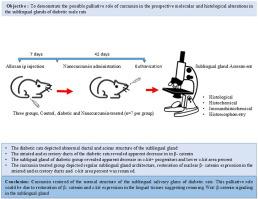Curcumin mitigates the histopathological and molecular changes in sublingual glands in diabetic male rats
Q1 Medicine
Journal of oral biology and craniofacial research
Pub Date : 2025-10-02
DOI:10.1016/j.jobcr.2025.09.023
引用次数: 0
Abstract
Objective
demonstrate the possible palliative role of curcumin in the prospective molecular and histological alterations in the sublingual glands of diabetic male rats.
Methods
Twenty-one male adult rats were used and randomly assigned into three groups (n = 7). The control group consisted of rats administered a single IP injection of saline. The diabetic group included rats receiving one dose of alloxan (140 mg/kg). The nanocurcumin-treated rat group (NC group) contained diabetic rats administered 200 mg/kg nanocurcumin. After 42 days, the salivary glands were dissected and assessed for Masson trichrome, Hematoxylin and eosin (H&E) staining, expression of c-kit and β-catenin, and histomorphometric analysis.
Results
The sublingual glands of diabetic rats revealed altered histology. In addition, the salivary tissues depicted an apparent change in β-catenin, and c-kit expression. The NC group resumed the normal sublingual gland architecture and c-kit and β-catenin expression.
Conclusion
Curcumin treatment rescued the histological and molecular changes in the sublingual glands of the diabetic rats. The ameliorating effect of curcumin on sublingual tissues of diabetic rats may be due to resuming of expression of β-catenin suggesting restoration of Wnt/β-catenin signaling in the glandular tissues which can maintain the c-kit + glandular stem/progenitor cells.

姜黄素减轻糖尿病雄性大鼠舌下腺的组织病理和分子变化
目的探讨姜黄素在糖尿病雄性大鼠舌下腺分子和组织学改变中的可能的缓解作用。方法选用雄性成年大鼠21只,随机分为3组(n = 7)。对照组大鼠单次IP注射生理盐水。糖尿病组大鼠给予一剂四氧嘧啶(140 mg/kg)。纳米姜黄素处理大鼠组(NC组)给药200 mg/kg纳米姜黄素。42 d后,解剖唾液腺,进行马松三色、苏木精和伊红(H&;E)染色、c-kit和β-catenin的表达和组织形态学分析。结果糖尿病大鼠舌下腺组织学改变。此外,唾液组织中β-catenin和c-kit的表达也发生了明显变化。NC组舌下腺结构恢复正常,c-kit和β-catenin表达恢复正常。结论姜黄素治疗可恢复糖尿病大鼠舌下腺的组织和分子变化。姜黄素对糖尿病大鼠舌下组织的改善作用可能是由于恢复了β-catenin的表达,提示恢复了腺组织中Wnt/β-catenin信号通路,从而维持了c-kit +腺干/祖细胞。
本文章由计算机程序翻译,如有差异,请以英文原文为准。
求助全文
约1分钟内获得全文
求助全文
来源期刊

Journal of oral biology and craniofacial research
Medicine-Otorhinolaryngology
CiteScore
4.90
自引率
0.00%
发文量
133
审稿时长
167 days
期刊介绍:
Journal of Oral Biology and Craniofacial Research (JOBCR)is the official journal of the Craniofacial Research Foundation (CRF). The journal aims to provide a common platform for both clinical and translational research and to promote interdisciplinary sciences in craniofacial region. JOBCR publishes content that includes diseases, injuries and defects in the head, neck, face, jaws and the hard and soft tissues of the mouth and jaws and face region; diagnosis and medical management of diseases specific to the orofacial tissues and of oral manifestations of systemic diseases; studies on identifying populations at risk of oral disease or in need of specific care, and comparing regional, environmental, social, and access similarities and differences in dental care between populations; diseases of the mouth and related structures like salivary glands, temporomandibular joints, facial muscles and perioral skin; biomedical engineering, tissue engineering and stem cells. The journal publishes reviews, commentaries, peer-reviewed original research articles, short communication, and case reports.
 求助内容:
求助内容: 应助结果提醒方式:
应助结果提醒方式:


